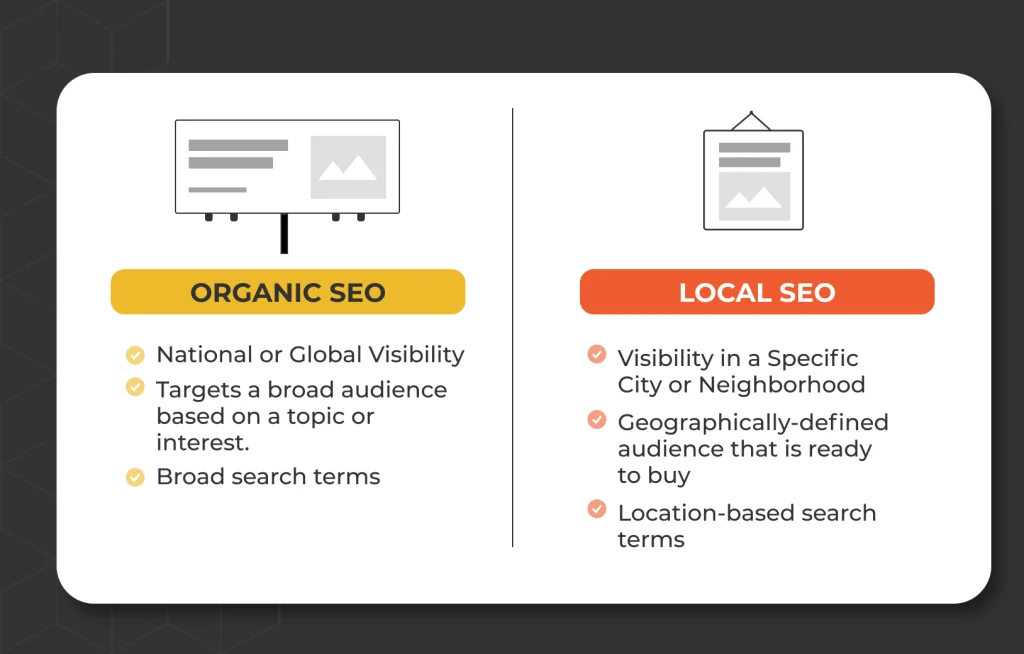Key Takeaways
- Organic SEO is Broad: Its goal is to achieve national or global visibility for broad topics and keywords. Think of it as a national billboard.
- Local SEO is Targeted: Its goal is to achieve visibility in a specific geographic area for “near me” or location-based searches. Think of it as the sign in your shop window.
- Different Ranking Factors: Organic SEO relies heavily on overall website authority and content, while Local SEO is heavily influenced by your Google Business Profile, local reviews, and geographic proximity.
- They Work Together: A strong digital strategy doesn’t choose between them; it uses both. A solid organic foundation boosts your local authority, and a strong local presence captures high-intent customers.
When it comes to digital marketing, two terms often cause some confusion among marketers: local SEO and organic SEO.
While they both aim to increase your visibility on search engines, they operate on different principles and serve distinct purposes. For high-end, enterprise-level clients, understanding the nuances and the synergy between these two strategies is crucial for building a commanding digital presence.
This guide will go beyond the basics, providing an in-depth look at how these two powerful forces work, why you need both, and how to implement a strategy that drives both brand authority and tangible, local results.
Understanding the Core Differences: A Quick Look
Before we dive deep, here is a simple breakdown of the fundamental goals of each strategy.
Organic SEO is about casting a wide net. It focuses on improving your ranking for broad, non-location-specific keywords to attract a national or global audience. Think of it as a national billboard.
Local SEO is a highly specialized subset. It aims to increase your visibility for location-specific searches, often triggered by “near me” or “in [city name]” queries. This is your local shop window sign.
Why One Cannot Thrive Without the Other
Many businesses make the mistake of choosing one strategy over the other. The reality is that for a robust, long-term digital presence, you need both. They are not mutually exclusive; they are a powerful, complementary duo.
Organic Boosts Local: A strong Organic SEO foundation—built on high-quality content, a technically sound website, and authoritative backlinks—signals to Google that your brand is trustworthy and relevant. This authority can positively influence your Local SEO rankings, helping you stand out in competitive “Map Pack” results.
Local Fuels Organic: A powerful local presence, fueled by positive reviews, local citations, and a well-optimized Google Business Profile (GBP), sends strong trust signals back to Google. This localized trust and relevance can indirectly improve your overall organic authority, broadening your reach.

What is Organic SEO? (The National Billboard)
Organic SEO (often called “traditional SEO”) is the practice of optimizing your website to rank for keywords on a national or global scale. The goal is to be the most authoritative answer for a given topic, regardless of where the searcher is located.
Who it’s for: E-commerce stores, SaaS companies, national brands, and bloggers who serve a broad audience.
Example Keyword: “how to choose the best running shoes”
Key Focus Areas: Creating high-quality blog content, building website authority through backlinks, and ensuring your website is technically sound.
What is Local SEO? (The Shop Window Sign)
Local SEO is a specialized subset of SEO focused on optimizing your online presence to attract more customers from local searches. The primary goal is to appear in the Google “Map Pack”—the box with a map and three business listings that appears for “near me” or location-based searches.
Who it’s for: Businesses with a physical location or a designated service area, like restaurants, dentists, plumbers, lawyers, and retail shops.
Example Keyword: “best running shoe store in Austin”
Key Focus Areas: Optimizing your Google Business Profile (GBP), managing online reviews, and building local citations (mentions of your business’s name, address, and phone number on other local websites).
Advanced Local SEO Tactics
Optimize Your Google Business Profile (GBP) for Impact: Don’t just claim your profile—master it.
Categories: Select the most accurate primary category and up to nine secondary categories.
Attributes: Use the “attributes” section to highlight unique business features like “wheelchair accessible” or “outdoor seating.”
Google Posts: Regularly post updates, offers, and events to keep your profile active and engaging.
Q&A Section: Proactively answer common questions to provide useful information and show your expertise.
Master Review Management: Reviews are a critical ranking factor.
Encourage Reviews: Create a simple, trackable short URL for customers to leave reviews and make it a standard practice to ask for feedback after a service or purchase.
Respond to All Reviews: Acknowledge positive reviews with gratitude. Politely and professionally address negative reviews, showing that you value customer feedback and are committed to resolving issues.
Review Schema Markup: Implement schema markup on your site to display your star ratings in search results, increasing click-through rates.
Ensure NAP Consistency: Your Name, Address, and Phone Number (NAP) must be identical across all online platforms. Inconsistent information confuses search engines and erodes trust.
- Key Directories: Prioritize major directories like Yelp, Apple Maps, and Bing Places, as well as industry-specific and local chamber of commerce listings.
Create Hyper-Localized Content: Think beyond service pages.
Local Blog Posts: Write content that appeals directly to your community, such as “Top 5 Family-Friendly Restaurants in [Your City]” or “A Guide to the Best Hiking Trails in [Your Area].”
Location-Specific Landing Pages: For businesses with multiple locations, create a dedicated, unique page for each, complete with a local phone number, testimonials, and an embedded Google Map.
Advanced Organic SEO Tactics
In-Depth Keyword Research: Move beyond simple keywords.
Understand Intent: Differentiate between informational keywords (e.g., “what is local SEO”) and transactional keywords (e.g., “local SEO services”).
Long-Tail Keywords: Target longer, more specific keyword phrases that have high user intent, such as “enterprise-level local SEO agency.”
Build Topical Authority with a “Hub and Spoke” Model:
Pillar Page (Hub): Create a comprehensive, long-form guide on a broad topic (e.g., this blog post).
Cluster Pages (Spokes): Write more detailed, specific articles on subtopics that link back to the hub (e.g., a dedicated post on “How to Respond to Google Reviews”).
Comprehensive Technical SEO: Your site’s foundation must be solid.
- Site Speed: Optimize images and leverage browser caching to ensure fast loading times on both desktop and mobile.
- Mobile-First Design: With mobile searches dominating, a responsive and intuitive design is no longer a luxury—it’s a necessity.
- Schema Markup: Use schema to help search engines understand the context of your content, leading to richer search results and a higher click-through rate.
Strategic Link Building: Earning high-quality links is the ultimate authority signal.
Content Partnerships: Collaborate with other high-authority businesses in your industry to create and promote content.
Guest Blogging: Contribute valuable, unique content to other reputable websites in exchange for a backlink.
AI and the Future of SEO
The rise of AI-powered search, including Google’s AI Overviews, reinforces the importance of the principles outlined above. AI models often pull information from trusted, authoritative sources. This means that a strong, comprehensive, and up-to-date online presence—built on the pillars of both Local and Organic SEO—will continue to be the most effective way to rank and to be accurately represented in AI-generated search results.
Furthermore, search engines are placing a greater emphasis on customer sentiment. Your review count and overall star rating are not just for potential customers; they are increasingly influential ranking signals that build trust with search engines themselves.
A United Strategy for Unmatched Success
The debate between Local SEO vs. Organic SEO is over. For enterprise-level brands, the answer is not “or” but “and.” A strategy that seamlessly integrates both will drive national brand recognition while simultaneously capturing high-intent, local customers.
By combining the wide-reaching power of Organic SEO with the laser-focused precision of Local SEO, you create a digital ecosystem that is both resilient and highly profitable.
Ready to build a strategy that works for your brand? At Fahrenheit Marketing, we specialize in crafting custom, comprehensive SEO solutions for high-end clients. Contact our Austin-based SEO experts can help you dominate the map.
